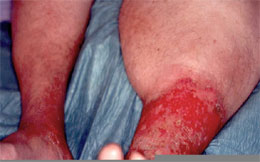What is Lipodermatosclerosis?
Lipodermatosclerosis is chronic inflammation with resultant fibrosis or sclerosis of the skin (derma) and subcutaneous fat (lipo) where the skin of the lower leg becomes scarred in a circumferential manner and the leg looks tapered like a 'chicken leg'.
Lipodermatosclerosis has been identified under many different names for years, as membranous lipodystrophy, lipomembranous fat necrosis and stasis associated lipomembranous panniculits, among others.
The hallmark of lipodermatosclerosis is the leathery skin, brown discoloration, hyperpigmentation and hypopigmentation of the skin, and circuferential or near circumferential scarring and shrinking of the extremtiy.
In the CEAP classification of venous disease, lipodermatosclerosis is classified as CEAP C4b disease.
Once patients are assessed by Dr. Karamanoukian and a venous Duplex scan is performed which utilizes a combination of ultrasound (B mode scanning) and Doppler scanning - together called Duplex scanning of the venous system, the legs are mapped with both Vein Lite and Vein Viewer Infrared technology. The CEAP classification is next used to document the type of venous disease and clinical severity scores are next utilized in addition to the morphological and pathological classification of venous diseases.
Video showing lipodermatosclerosis by Dr. Karamanoukian
image of advanced lipodermatosclerosis (chronic) from Dr. Karamanoukian's book - A Guide to Lipodermatosclerosis (in print)

Image of chronic lipodermatosclerosis.

image of chronic lipodermatosclerosis from Dr. Karamanoukian's book - A Guide to Lipodermatosclerosis (in print)